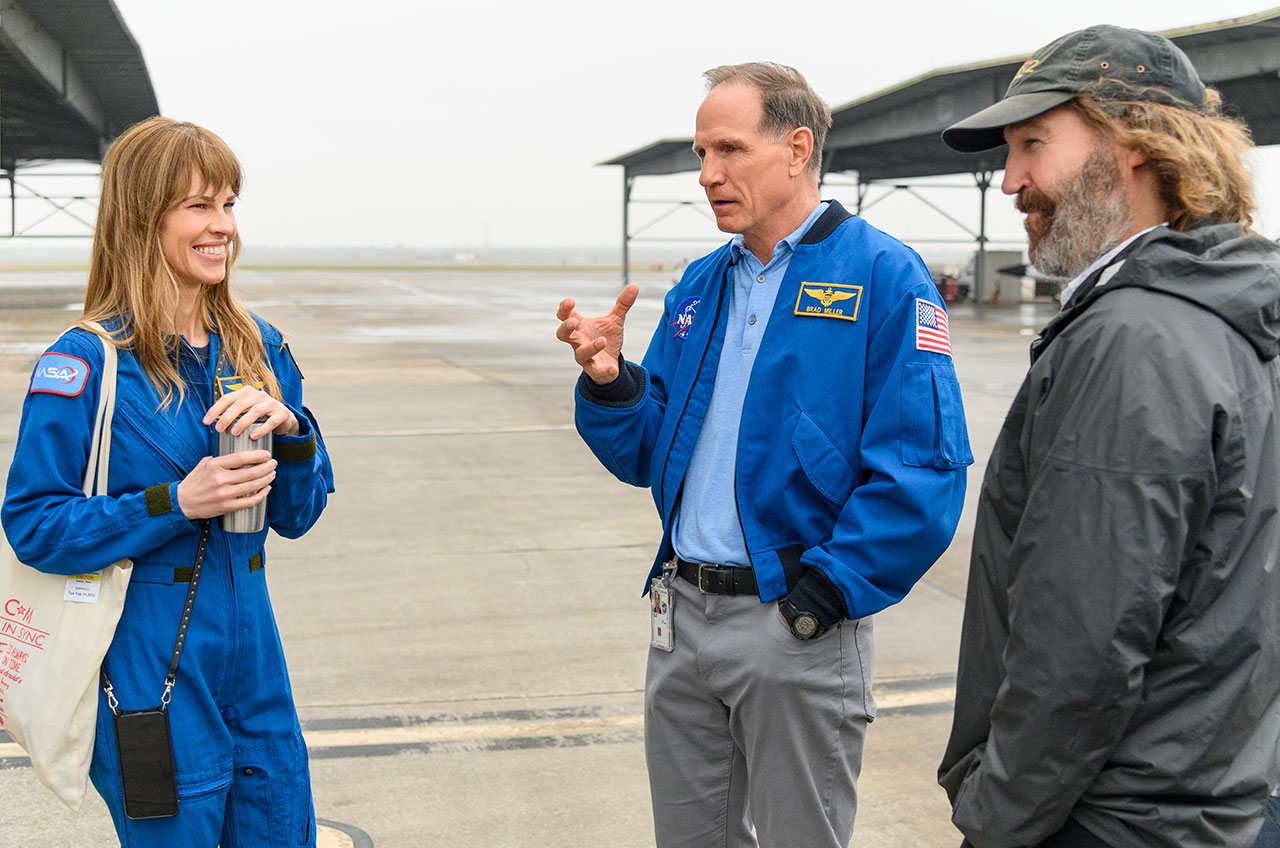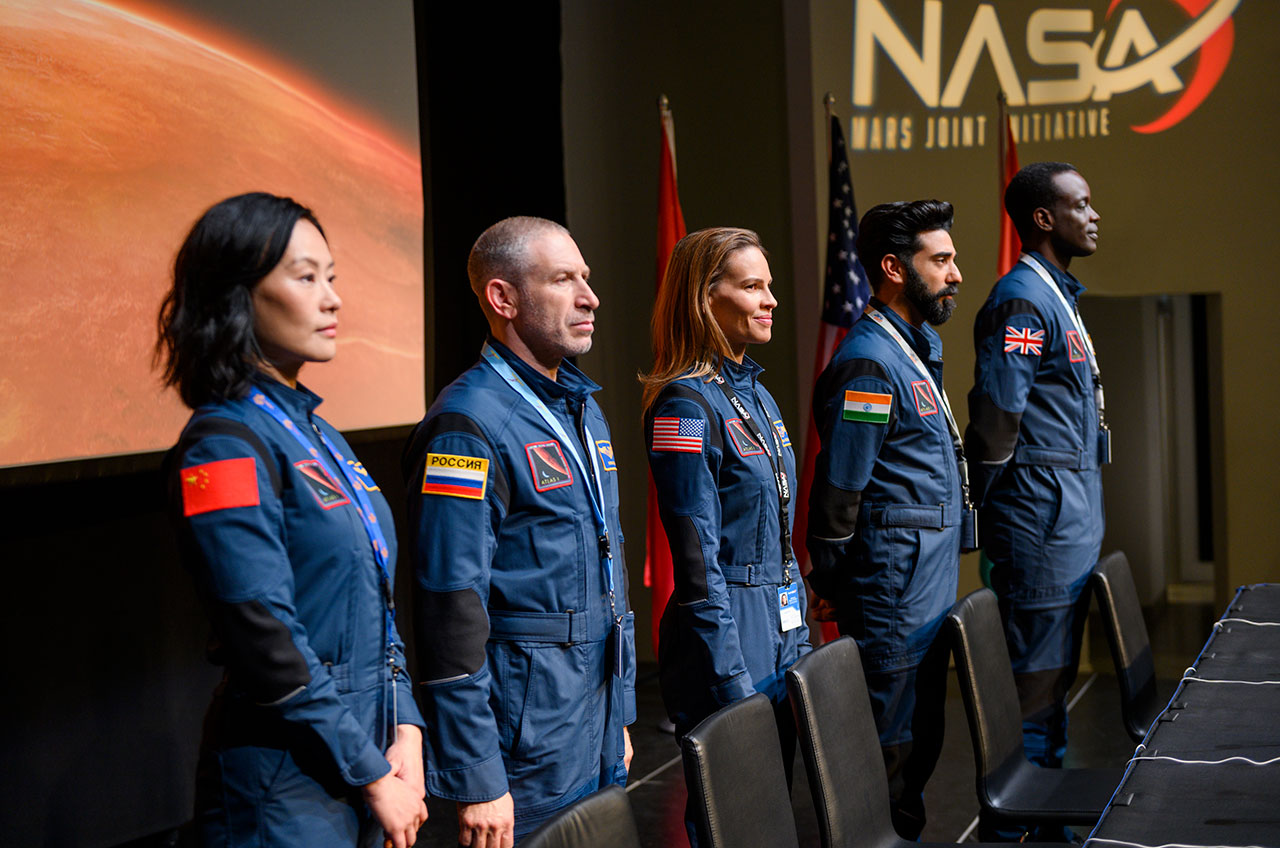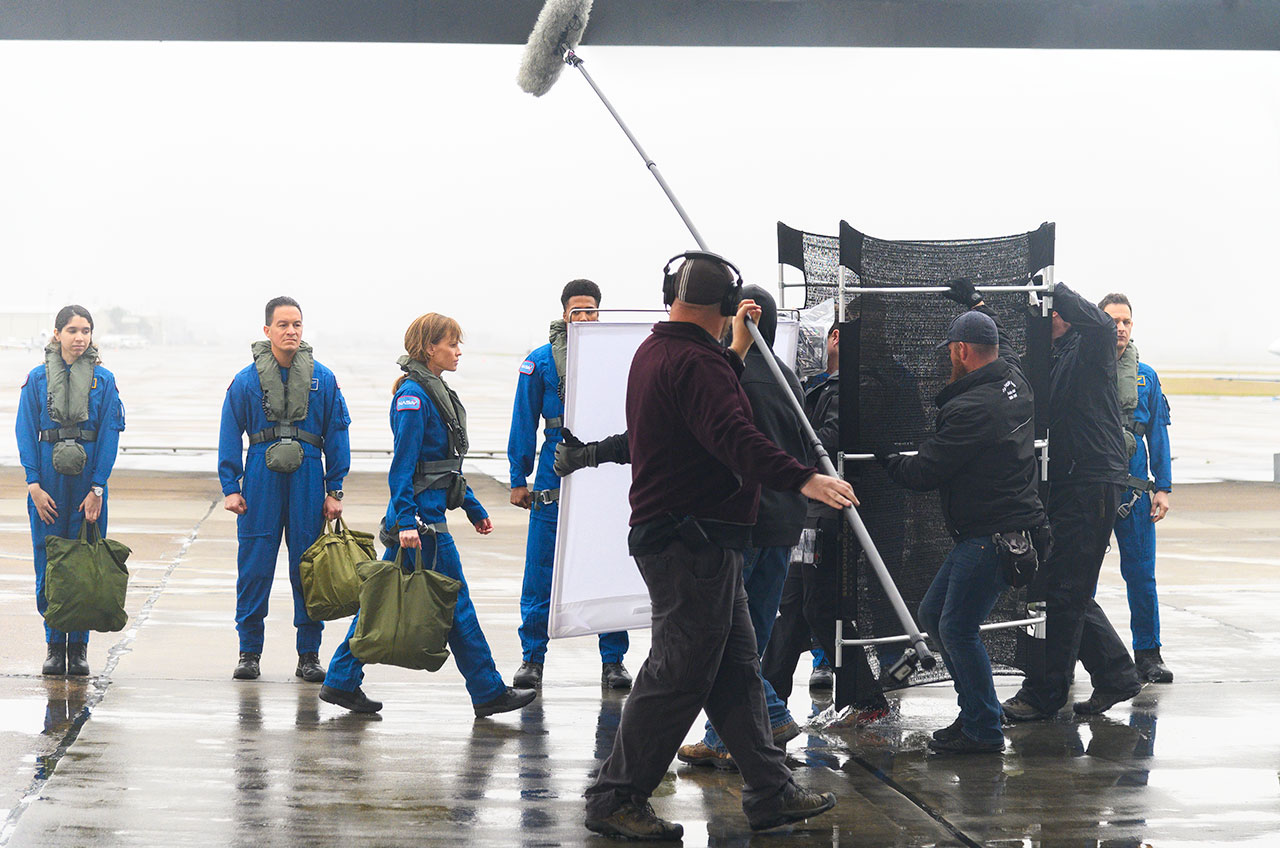Netflix Mars mission series 'Away' lifts off with nods to NASA history
One scene looks like it's ripped from reality. Because it is.
In a show that is primarily set aboard a fictional spacecraft flying through simulated space, there is a scene in the new Netflix Mars mission series, "Away," that looks particularly close to the real thing — and that is because it is.
Towards the end of the one the 10 episodes that began streaming Friday (Sept. 4), astronauts Emma Green and Matt Logan, played by actors Hilary Swank and Josh Charles, are seen getting ready to train using NASA T-38 jets. The aircraft are emblazoned with NASA's iconic insignia and for those in the know, the setting may look familiar.
The scene was filmed on location at Ellington Airport (formerly Ellington Field) in Houston, home to NASA's flight operations and its fleet of astronaut training jets.
Related: Hilary Swank takes us to Mars in Netflix's 'Away' (review)
More: 20 sci-fi movies and TV shows to binge watch on Netflix right now

"Thanks for visiting us, Hilary Swank!" NASA's nearby Johnson Space Center posted to its social media accounts in February, after Swank toured the facilities. "We're glad we could take you Away from the real world for a day and show you the home of human spaceflight."
In "Away," Swank's Green commands an international crew on humanity's first journey to Mars. Loosely based on Esquire magazine writer Chris Jones' account of real-life astronaut Scott Kelly's yearlong mission aboard the International Space Station, "Away" examines the physical and psychological challenges that come as a result of leaving Earth behind for an extended trip into space.
Set in the near future, "Away" features spacesuit costumes and spacecraft sets inspired by NASA equipment, as well as the hardware devised and used by other space agencies and commercial spaceflight companies. Like the Ellington shoot, though, there are several details spread throughout the new series that offer more direct nods to real space exploration.
Related: The awesome NASA Easter eggs of Netflix's 'Lost in Space'
Get the Space.com Newsletter
Breaking space news, the latest updates on rocket launches, skywatching events and more!
Mission patches

The sight of the authentic NASA insignia on the tails of the T-38 jets stands out in "Away" because, for the most part, the production replaced the real emblem with a design of their own.
"We had to recreate the space agency logos, even NASA's, because you aren't allowed to use that," costume designer Kimberly Adams said in a Netflix interview. "David [Sandefur, production designer] developed something that was just a little bit different, and he did the same thing with the other space agencies as well."
NASA requires an agreement before film productions can use its logo.
Sandefur also created slightly-off versions of the European Space Agency (ESA), China National Space Administration (CNSA), Indian Space Research Organization (ISRO) and Russian federal space corporation Roscosmos insignia and their related patches.

"It was overwhelming how much work the world of the patches was," said Adams. "Patches in the world of NASA are a huge deal. If you look back at the history of the patches, they're so intricate with so many details blended into them."
"From the very beginning, from our first walk on the moon, astronauts have been part of the design process. They're not the ones that physically sketch it out, but they come up with the elements that are important to their mission and to the work they're doing to ensure that those components are reflected in their patches," she said.
The astronauts in "Away" — including Russian cosmonaut Misha Popov (Mark Ivanir), India's Ram Arya (Ray Panthaki), Chinese astronaut Lu Wang (Vivian Wu) and Kwesi Weisberg-Abban (Ato Essandoh), a British citizen from Ghana — wear flight suits that display their respective country's flag on one arm, their mission patch on the other and then on the front, a repetition of the space agency patches.
"If you're out in space on the ship in the full suit, you can tell who is near you by their patch and their colors. I found that so interesting," Adams said.
Related: Tom Cruise, SpaceX, NASA developing action film shot in space
Namesakes
Green (Swank) and her four fellow astronauts comprise the crew of the Atlas, an interplanetary spacecraft that borrows some of its look from real-world vehicles.
"The design connects back to NASA and their Orion mission," said Sandefur. "The engineering that they were putting into their command module is what I used as the inspiration for the design in 'Away.' Everything on the ship is controlled from one panel via touch screens and a number of analog backups, which is what Orion is doing as well. Equally, SpaceX also has their Dragon capsule."
Although left unstated in the series, the name "Atlas" also has a connection with NASA's efforts to explore Mars as the name of the rocket that has launched numerous of the space agency's robotic probes and rovers to orbit and land on the Red Planet.
The namesakes don't end there, though. The Atlas in "Away" has three key parts that share names with the original components of the International Space Station (ISS). The fictional spacecraft's three large solar arrays are referred to as "Zarya," "Unity" and "Zvezda."
In reality, the Zarya (Russian for "Dawn") functional cargo block (FGB) was the first module launched into Earth orbit to begin assembling the ISS in 1998. It was followed by Unity, the first U.S. connecting node, which was docked to Zarya.
The Zvezda (Russian for "Star") service module was the third piece to expand the size and utility of the space station in 2000.
"[Writer] Chris Jones talks about how the International Space Station came to be and how it was truly an international collaboration. It required the world to work together and countries that normally didn't get along, to get along," series creator Andrew Hinderaker said. "On a global level, that really resonated with me."
Sss ... space history

Many of the challenges that the Atlas crew face were inspired or informed by events from real space history. Some are more obvious than others, but there are also a few times when the "Away" astronauts cite missions by name, setting their timeline within our own.
In addition to a passing, but poignant reference to the space shuttle Columbia, which was lost with its crew in 2003, "Away" also acknowledges NASA's past on Mars, including the robotic rovers and landers that preceded the Atlas-1 launch.
And then there is the series' ninth episode, which adopts a dramatic event from space history as its title, "Spektr."
"Spektr is a Russian ghost story. Only problem is that it actually happened," says Popov (Ivanir), speaking to his crewmates.
"In 1997, the space station Mir was hit by an approaching freighter. The module that was punctured was called Spektr," explains Wang (Wu) in response.
"Yeah, the story always begins with 'sssss...'" continues Popov. "It is the sound of air rushing out of the capsule into the vacuum of space as astronauts feel change of pressure in their ears and wait for their brains to explode."
"Only their brains didn't explode because they were able to get out of the module and close it off in time," says Green (Swank).
Name drop
Other than hardware, the Atlas crew also name drops a few real-life astronauts.
Apollo 11 moonwalkers Neil Armstrong and Buzz Aldrin each get call outs, at separate times for different reasons.
The other real-world crossover is Mike Massimino, who was a technical advisor to the series and makes a cameo appearance in the first episode.
"I think the biggest challenge is going to be is that they are really going to be, no kidding, away, and that means away from our planet, away from their family..." says Massimino, playing himself — a former NASA astronaut who helped service the Hubble Space Telescope on two shuttle missions — during an in-episode television interview.
Off camera, Massimino said he thinks "Away" will inspire viewers to find out what is possible in space.

"We obviously haven't been to Mars yet for real, but through this show, it made me feel that we are getting closer, which is great," he said in an interview with Netflix. "Today I am wearing my astronaut class patch from 1996 and there are flags of the different countries on it that were represented from my class. We also have Mars depicted on our class patch because we were so hopeful back then, over 20 years ago, that one of us in my astronaut class would get a chance to be selected to go to Mars. That didn't happen, but I think it will hopefully happen in the not-too-distant future."
"I am just happy that it is going to happen fairly soon here with 'Away' and so I am so glad to be a part of that," Massimino said.
Follow collectSPACE.com on Facebook and on Twitter at @collectSPACE. Copyright 2020 collectSPACE.com. All rights reserved.
Join our Space Forums to keep talking space on the latest missions, night sky and more! And if you have a news tip, correction or comment, let us know at: community@space.com.

Robert Pearlman is a space historian, journalist and the founder and editor of collectSPACE.com, a daily news publication and community devoted to space history with a particular focus on how and where space exploration intersects with pop culture. Pearlman is also a contributing writer for Space.com and co-author of "Space Stations: The Art, Science, and Reality of Working in Space” published by Smithsonian Books in 2018.In 2009, he was inducted into the U.S. Space Camp Hall of Fame in Huntsville, Alabama. In 2021, he was honored by the American Astronautical Society with the Ordway Award for Sustained Excellence in Spaceflight History. In 2023, the National Space Club Florida Committee recognized Pearlman with the Kolcum News and Communications Award for excellence in telling the space story along the Space Coast and throughout the world.










